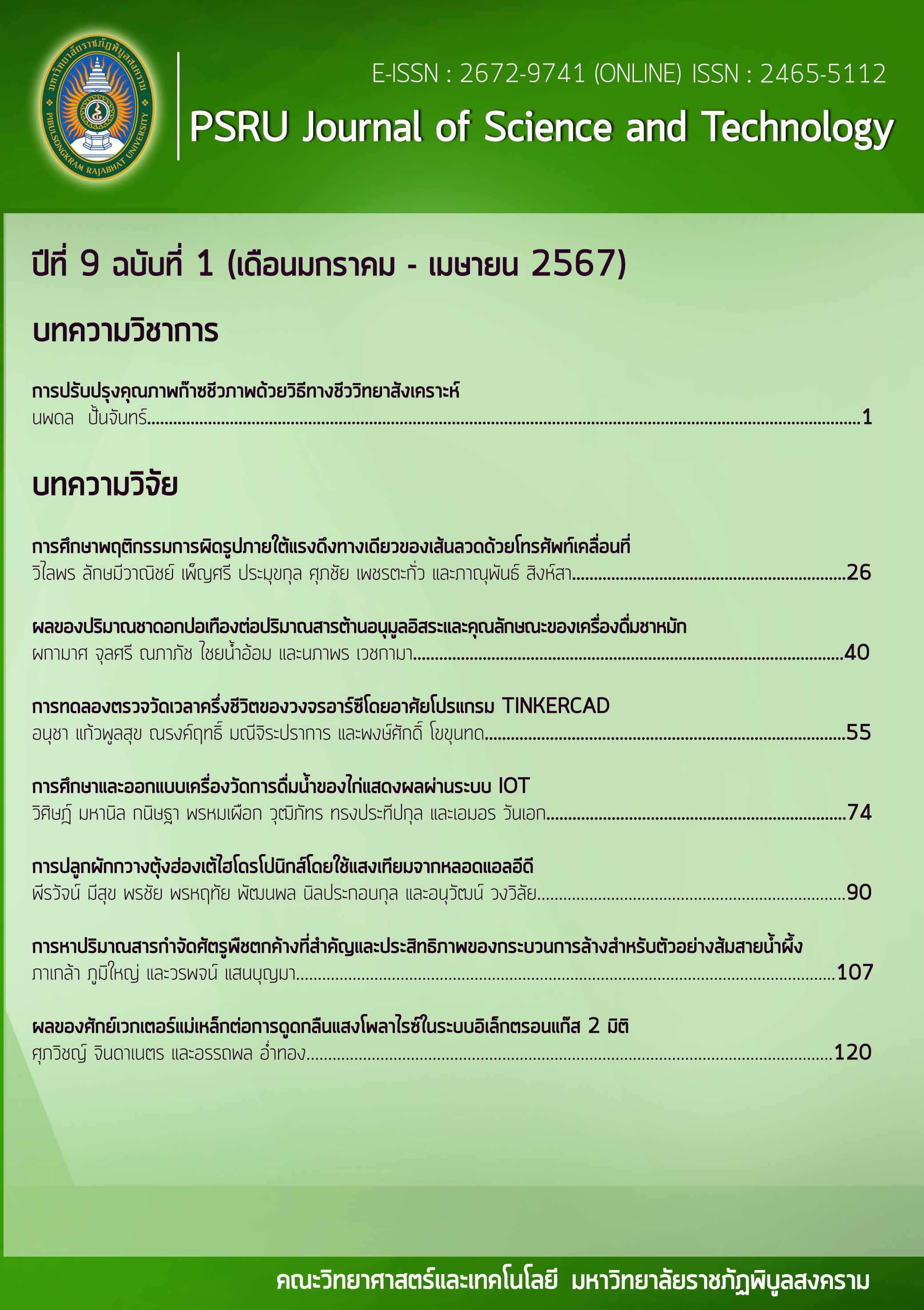THE EFFECT OF SUNN HEMP FLOWER TEA CONTENTS ON TOTAL ANTIOXIDANT CAPACITY AND CHARACTERISTICS OF FERMENTED TEA
Keywords:
Sunn hemp, Fermented tea, AntioxidantAbstract
The purpose of this research was to study the effect of Sunn hemp flower tea contents on total antioxidant capacity and characteristics during Sunn hemp flower tea fermentation process, as well as sensory testing of Sunn hemp flower tea fermented products. The experiment was conducted by varying the amount of Sunn hemp flower tea at 10, 30 and 50 g/l. The results showed that the optimal amount of Sunn hemp flower tea for Sunn hemp flower tea fermentation was 10 g/l, which the antioxidant capacity was significantly increased (P<0.05) during the 7 days of fermentation and had the highest inhibition capacity of 0.49 mg TE/ml at 21 days of fermentation. While the total titratable acidity (% acetic acid) was increased and pH decreased during the fermentation process, total soluble solids tended to decrease and the number of bacteria and yeast were increased at the 7 days. In addition, the results on color values of Sunn hemp flower tea fermented revealed L* (lightness value) were decreased and b* (yellow value) were increased in the initial tea as rise in the amount of tea. But no significant changes in color values were observed during the fermentation process. The sensory testing of Sunn hemp flower tea fermented by untrained subjects found the highest overall acceptability score of 7.13 in Sunn hemp flower tea content of 10 g/l. Therefore, these experiment data on Sunn hemp flower tea fermented content of 10 g/l could be used for developing fermented tea beverages in the future.
References
ขนิษฐา พันชูกลาง, ฤทัยวรรณ บุญครองชีพ, วนิดา เพ็ชร์ลมุล, และอภิชาติ พันชูกลาง. (2564). ปริมาณฟีนอลรวม แทนนิน และฤทธิ์ต้านอนุมูลอิสระในชาปอเทือง. วารสารวิทยาศาสตร์และเทคโนโลยี, 29(4), 653-665.
นันธิดา ลิ่มเสฎโฐ. (2557). สารต้านอนุมูลอิสระในผลิตภัณฑ์ ใบชา ใบหม่อน และใบมะรุม (รายงานการวิจัย). สงขลา: มหาวิทยาลัยราชภัฏสงขลา.
นิสา ร่มส้มซ่า, จุฑามาศ พรสันเทียะ, ทิพย์วรินทร์ ริมลำดวน, และกุณฑิกา เวชกลาง. (2564). คุณสมบัติทางชีวภาพของผลิตภัณฑ์คอมบูชาที่เกิดขึ้นในระหว่างกระบวนการหมัก. วารสารนเรศวรพะเยา, 14(1), 75-87.
ปฏิญญา มั่นเกษตรกิจ, และสกุณณี บวรสมบัติ. (2561). การพัฒนาผลิตภัณฑ์คอมบูชาจากชาดำ โดยใช้เชื้อบริสุทธิ์. ใน การประชุมวิชาการเสนอผลงานวิจัยระดับชาติและนานาชาติ ครั้งที่ 8 (น. 1344-1355) กรุงเทพฯ: มหาวิทยาลัยราชภัฏสวนสุนันทา.
พรพิมล ควรรณสุ. (2548). ผลของพันธุ์และระดับการขัดสีข้าวต่อการเปลี่ยนแปลงองค์ประกอบทางเคมีระหว่างการหมักไวน์ข้าว. (วิทยานิพนธ์ปริญญามหาบัณฑิต). จุฬาลงกรณ์มหาวิทยาลัย, คณะวิทยาศาสตร์, สาขาวิชาเทคโนโลยีชีวภาพ.
สถาบันเทคโนโลยีจิรดา. (2562). Kombucha ชาหมักเครื่องดื่มสุดฮิต พบงานวิจัยไทยใช้อัญชัน มะตูม ดอกกระเจี๊ยบ ช่วยเพิ่มสรรพคุณ. สืบค้นเมื่อ 5 สิงหาคม 2564, จาก http://omni-recipes.com/2019/01/10/kombucha/?fbclid=IwAR2X8ZLRI8j4edtYH3q9VltrnSDeya7P-eSOuPHYo5jVXkLKRSOXlmLeJo
Aloulou, A., Hamden, K., Elloumi, D., Ali, M.B., Hargafi, K., Jaouadi, B., Ayadi, F., Elfeki, A., & Ammar, E. (2012). Hypoglycemic and antilipidemic properties of Kombucha tea in alloxan-induced diabetic rats. BMC Complementary & Alternative Medicine, 12(63). https://doi.org/10.1186/1472-6882-12-63
AOAC. (2000). Official methods of analysis. (17th ed.). USA: Association of Official Analytical Chemists.
Cobley, L.S., & Steele, W.M. (1976). An Introduction to the Botany of Tropical Crops. (2nd ed.). London: Longman Group Limited.
Cook, C.G., & White, G.A. (1996). Crotalaria juncea: A potential multi-purpose fiber crop. In J. Janick (Ed.), Proceeding of National Symposium on New Crops (pp. 389-394). ASHS Press: Arlington.
Jayabalan, R., Chen, P.N., Hsieh, Y.S., Prabhakaran, k., Pitchai, P., Marimuthu, S., Thangaraj, P., Swaminathan, K., & Yun, S.E. (2011). Effect of solvent fractions of Kombucha tea on viability and invasiveness of cancer cells-characterization of dimethyl 2-(2-hydroxy-2-methoxypropylidine) malonate and vitexin. Indian Journal of Biotechnology, 10, 75-82.
Jayabalan, R., Malbasa, R.V., Loncar, E.S., Vitas, J.S., & Sathishkumar, M. (2014). A review on kombucha tea-microbiology composition, fermentation beneficial effects toxicity and tea fungus. Comprehensive Reviews in Food Science and Food Safety, 13(4), 538-550.
Jayabalan, R., Marimuthu, S., & Swaminathan, K. (2007). Changes in content of organic acids and tea polyphenols during Kombucha tea fermentation. Food Chemistry, 102(1), 392-398.
Nurikasari, M., Puspitasari, Y., & Siwi, R.P.Y. (2017). Characterization and analysis kombucha tea antioxidant activity based on long fermentation as a beverage functional. Journal of Global Research in Public Health, 2(2), 90-96.
Sreeramulu, G., Zhu, Y., & Knol, W. (2000). Kombucha fermentation and its antimicrobial activity. Journal of Agricultural and Food Chemistry, 48(6), 2589–2594.
Wanyo, P., Siriamornpun, S., & Meeso, N. (2011). Improvement of quality and antioxidant properties of dried mulberry leaves with combined far-infrared radiation and air convection in Thai tea process. Food and Bioproducts Processing, 89(1), 22-30.
Yang, Z.W., Ji, B.P., Zhou, F., Li, B., Luo, Y., Yang, L., & Li, T. (2009). Hypocholesterolaemic and antioxidant effects of kombucha tea in high-cholesterol fed mice. Journal of the Science of Food and Agriculture, 89(1), 150-156.
Downloads
Published
Versions
- 2024-05-29 (2)
- 2024-04-19 (1)
How to Cite
Issue
Section
License
Copyright (c) 2024 PSRU Journal of Science and Technology

This work is licensed under a Creative Commons Attribution-NonCommercial-NoDerivatives 4.0 International License.
กองบรรณาธิการขอสงวนสิทธิ์ในการปรับปรุงแก้ไขตัวอักษรและคำสะกดต่างๆ ที่ไม่ถูกต้อง และต้นฉบับที่ได้รับการตีพิมพ์ในวารสาร PSRU Journal of Science and Technology ถือเป็นกรรมสิทธิ์ของคณะวิทยาศาสตร์และเทคโนโลยี มหาวิทยาลัยราชภัฏพิบูลสงคราม และ
ผลการพิจารณาคัดเลือกบทความตีพิมพ์ในวารสารให้ถือมติของกองบรรณาธิการเป็นที่สิ้นสุด






